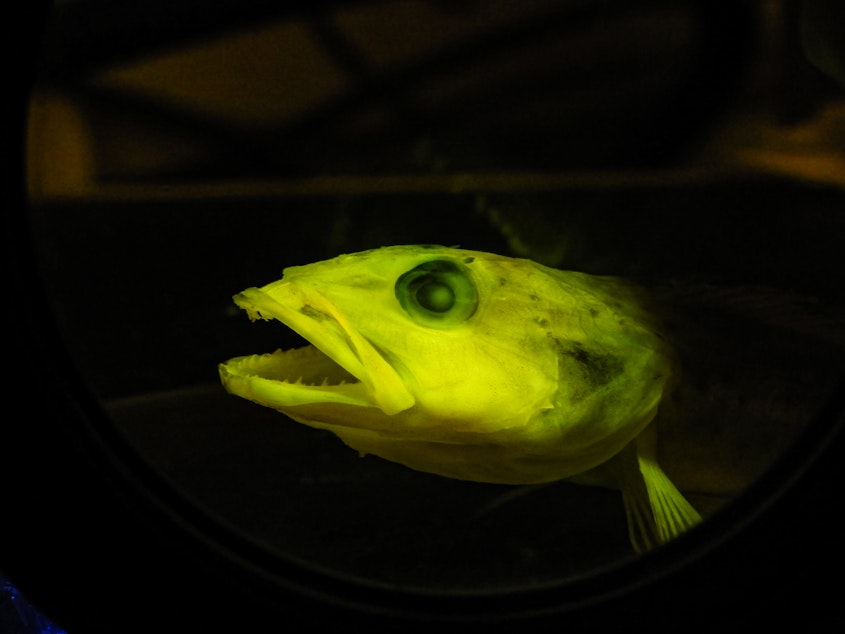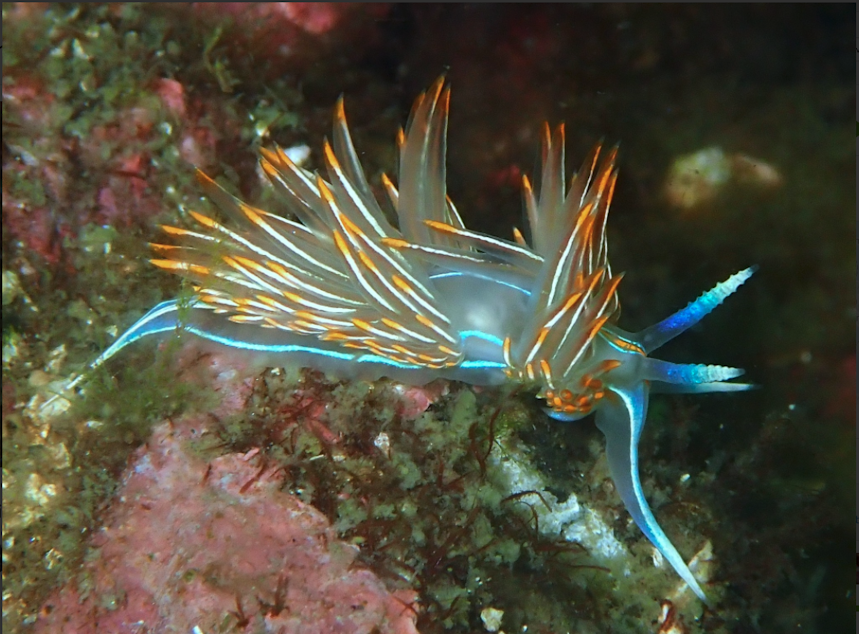Our neighbors Sound-under

Soundside takes a deep dive into the waters around Washington to learn about some of our less appreciated neighbors. Because while they may be lesser-known, they have a lot to tell us about our ecosystems, and might even offer some innovative solutions to everyday problems.
What do you know about lingcod?
You might know that they have big, bulbous eyes, and sometimes have blue flesh that looks fluorescent. But did you know they have 500 teeth?
That's over 15 times more teeth than the average person.
It takes a lot of work growing that many teeth. In fact, lingcod lose teeth constantly, and grow around 20 new ones every day.
Sponsored
Karly Cohen, a PhD candidate at the University of Washington and Friday Harbor Labs, says fish typically loose teeth pretty often.
"You and I are very familiar with losing our teeth as babies and just once we go through that ordeal once in our life, and that's just not true for many of the vertebrates or fishes that are on the planet today. In fact, they're replacing their teeth all the time."
And fish need to replace those teeth, because they wear out way quicker than a human's.
"When you have a sharp and pointy tooth, it's great to use the first time around, and maybe even the second or third. But by the time that same tooth is interacting with prey and food, say it's tenth time, it's much more dull. And so in these fishes that can replace twenty teeth a day, they get to keep that sharp edge, which means every time they interact with a prey item, they have a better chance of keeping it."
Sponsored
Is that a fish or a suction cup?

If you walk along the shores of Puget Sound and flip over a rock, or peek into a tide pool, there’s a good chance you’ll come across the small, yet mighty, Northern clingfish.
Their body is about the size of a human finger, but their suction force can help them hold over 200 times their own body weight. It puts the suction cups in our everyday shower caddies to shame.
In 2013, Dr. Petra Ditsche joined a group of researchers at the University of Washington’s Friday Harbor Laboratories, that set out to understand how a small critter like the Northern clingfish could pack such serious sucking power.
Sponsored
“The northern clingfish has a suction cup on its belly. It’s derived from the pelvic and the pectoral fins. It’s a very specific suction cup because it enables attachment to rough surfaces.”
The Northern clingfish’s suction cup is covered in tiny knobs. If you zoom in on those knobs with a microscope, you can see tiny hairs, similar to the ones you find on geckos' feet. Those hairs create friction, and prevent the edges of the clingfish’s suction cup from moving or popping off slippery, bumpy surfaces.
Dr. Ditsche found that depending on the size of the clingfish, they can tightly attach to surfaces as porous and rough as sandstone. That helps clingfish to stay stuck in tidepools and to feast on prey. Even though the average Northern clingfish is between three to six inches, many are able to attach to objects with forces up to 250 times its own body weight.
That helps clingfish stay stuck in tidepools, and avoid being eaten by other sea creatures.
“If you look at the marine intertidal, there can be waves which come in and out and crashing waves can sweep this little fish, or could slap this little fish away quite easily if it wouldn't have the suction cup on its belly with which it can cling to the rocks,” Ditsche said.
After studying the Northern clingfish, Dr. Ditsche and other researchers at the lab started developing prototypes for a suction cup inspired by the tiny saltwater fish. Eventually, Ditsche was able to build a cup that was rigid, but also soft and flexible enough to attach and stay stuck on wet, bumpy surfaces.
That bioinspired suction cup couldn't have been created at a better time for Rob Magrino, the founder of AquaBlastFit.
The Edmonds-based company sells portable fitness bags you can use for strength training or exercising in a swimming pool. When Magrino’s bag hit the market in July 2020, it met his expectations for a lightweight, durable piece of workout equipment. But customers flagged an issue.
Sponsored
“There was no way to really keep the bag in place in the swimming pool, because it's filled with water and would just drift away,” Magrino recounted. “And so people said, ‘You've got to find a way to tether it to the pool somehow.’”
Suction cups already on the market just weren’t hitting the mark. The rough, textured floors of swimming pools made it difficult for the cups to stay sucked to the pool floor, and many weren’t strong enough to support the force of the bag.
So Magrino turned to the internet, where he found a news story about Dr. Ditsche’s clingfish inspired suction cup. Over the last couple of years, the researcher and entrepreneur have collaborated to perfect it for Magrino’s workout bags. Magrino hopes the suction cup and tether he’ll be selling later this spring will make a difference for customers, especially those who are using his products for physical therapy.
“Cling fish is going to change a lot of people’s lives, that’s what I know. Petra’s work on the suction cup is really an incredible invention,” Magrino said. “I’ve heard it called velcro for swimming pools, that it sticks that firmly.”
And it’s all thanks to the northern clingfish, the best suction cup Puget Sound has to offer.
Sponsored
Secret photogenic power

Luan Roberts' obsession with nudibranchs first started on a trip to the San Francisco Bay Area. She was already an avid explorer of our shorelines, and was working on connecting people to their local environment through tide pooling.
"As with most creatures at low tide they're kind of droopy, and they're not really in their best state," Roberts said. "They just look like little snotty things, and you don't really pay them much attention."
It wasn't until she began seeing photos of nudibranchs under the water, up close, that their vibrancy captured Roberts' attention. And there were other benefits with searching for sea slugs — she wouldn't have to time her travels around tide tables. She could go to any marina in Puget Sound and basically guarantee a slug slighting.
Roberts is part of a wave of community members taking up the practice of "dock fouling."
Technically speaking, dock fouling refers to the flora and fauna attached to boats and other marina structures, which over long spans of time actually cause damage to marinas (that's where the word "fouling" comes from). But it's come to have a secondary meaning as people like Roberts crawl across docks on hands and knees to spot and catalog a variety of sea creatures. Sea slugs have a special affinity for long strands of kelp, and you can also find them on submerged nets.
So what is life like as a sea slug like? Short and sedentary.
"They basically just eat and reproduce," Roberts said. "All nudibranchs are predators, so they're feeding on other live animals. For the most part that's anemones, and bryozoans, and other stationary creatures."
And docks aren't the only other place to find sea slugs. Karin Fletcher regularly scuba dives for nudibranchs in Rich Passage, which is the equivalent of her front yard. She's been searching for sea slugs over the past 12 years and has identified just over 62 species — some of which hadn't been discovered yet.
"Things seem to be curious about you," Fletcher said. "The fish will swim up to you, the sea lions will swim up to you. They want to know what alien is in their world. And it is an alien world. It's so different from the top side that it's like going to another planet, just right out the front door."
Both Fletcher and Roberts have brought new attention to sea slugs, which have largely evaded recognition due to their size and lack of economic value. This past fall, Roberts organized a "docktober" event to bring people to their local marina, where she taught new enthusiasts how to safely observe dock fauna, and her nudibranch-themed instagram is currently thriving.
But there is some concern with how growing popularity might impact the health of nudibranchs, especially as the popularity of tide pooling on Instagram has attracted foragers and decimated some ecosystems.
"Dock fouling is a bit different in that you're going to place which is already sort of a human constructed environment," Roberts said. "You don't have much control over that environment because the marina owner could decide to scrape the side of the docks. Those organisms are only there at the invitation of the people who control that area."
Roberts said that the community has talked about creating a code of ethics for dock fouling, so new enthusiasts can be respectful of all who call our marinas home -- slugs or otherwise. But the community is all in on bringing more people to this unique corner of our local aquatic world, and it's up to community scientists to continue unlocking new sea slug secrets.
"I think that's what makes them special. They're just these special things that don't really have any value to anyone except for the people who can appreciate them for what they are."







